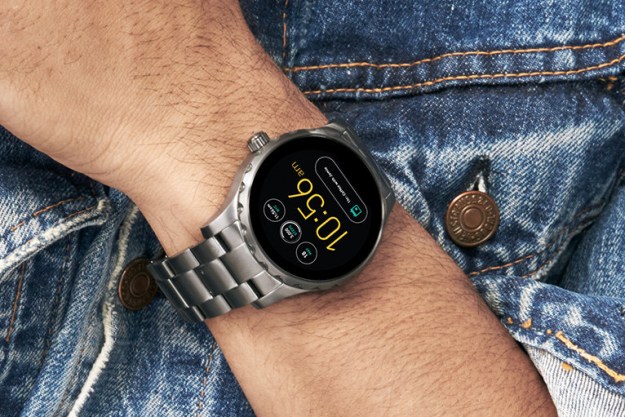
Things start to get a lot more complicated once screens enter the picture. But what else is new, right? Look at the smartphone market. Many aspects of their design have been standardized from manufacturer to manufacturer, yet screen size has only become more divergent.
That, coupled with the fact that more than 90 percent of all smartphones are essentially running one of two operating systems, has made displays the primary method most device makers are using to differentiate themselves. As more and more companies begin to jump into the wrist-worn smart device space, we’re beginning to see something similar play out, but for a number of reasons, there just isn’t as much space to play around.
The fashion cycle tends to move at a much brisker rate than the pace of human evolution.
Let’s start with the obvious one: the limits of the human body. When the first Galaxy Note was introduced in 2011, plenty of pundits laughed at the thing. Surely no reasonable person would be caught dead carrying around such a massive device. Of course, three years later, 5.3 inches seems downright modest when plenty of devices are pushing 6 inches. But the point remains. There were some simple practical concerns, including whether or not a device that large would fit in a standard-size pocket.
We as a culture have persevered. And, let’s face it, pockets can always get larger. But the fashion cycle tends to move at a much brisker rate than the pace of human evolution. Whatever the good folks at BlackBerry might tell you, the opposable thumb wasn’t developed for typing on small objects.
And while smartphones have been poking at the upper limits of maximum screen size over the last few years, wearable makers hit upon that ceiling almost immediately. When we’re talking about the human wrist, there’s just not a whole heck of a lot place to go, and actively making wearers uncomfortable defeats the purpose of a wearable.

A well made wearable is one you don’t remember you’re wearing most of the time. It ought to be inconspicuous enough so as to forget about its existence until you need to consult it. This is one of the primary issues with devices like Glass — Google had the incredibly unenviable task of creating a wearable device that’s subtle enough so that the wearer forgets it’s on their face for most of the day (or however long the battery lasts), while standing out enough so that bystanders know that the person standing at the urinal next to them essentially has a camera attached to their face.
Once your smartwatch or fitness band constricts your wrist movement, it’s kind of game over for the device. This, it turns out, is precisely why traditional watches have provided such a solid example to follow: Smartphone makers are building upon hundreds of years of trial and error in developing technology for the human body. No matter how smart your smart device ultimately is, the same parameters of comfort still apply here. The more things change, the more they stay the same, and all that.
The opposable thumb wasn’t developed for typing on small objects.
Like the Galaxy Note before it, Samsung’s Galaxy Gear was initially mocked by the press for its gigantic, ungainly size. This time, however, the gadget-buying public has seemingly sided with pundits. As popular as giant phones have become in recent years, consumers seem to have pretty roundly confirmed that they don’t want wearables that dwarf their wrists.
The Microsoft Band may well be doomed to a similar fate for similar reasons. The company simply couldn’t walk the line between comfort and functionality. We spoke to the company’s General Manager of Personal Devices, Zulfi Alam, about the matter when doing our review. He told us, “We did hundreds of studies with consumers. We felt we had the best balance we could come up with. Over time we’ll get it to be thinner, sleeker. There are certainly products that have greater comfort, but they only do a tenth of what we do.”
Fair enough. But Microsoft didn’t strike that golden ratio this time out, and for that reason, the product has many of the trappings of a first-generation device. It makes sense — mice and gaming controllers aside, personal comfort isn’t really the sort of thing that Redmond has had to factor into its products.

And that, ultimately, is the issue with these early smart wearables: striking that perfect balance between “smart” and “wearable.” In Microsoft’s case, that may ultimately mean dropping a few sensors in the short term. Ultimately, however, as the wearable space gets larger, components will get smaller, thanks to manufacturer scaling. Whether it will happen fast enough for the second-generation Band to have more functionality and less inclination for inducing carpal tunnel syndrome remains to be seen.
Ultimately the popularity of wearables will also likely drive companies like Samsung to invest even more heavily in nascent flexible display technology, which will almost certainly push the limits on screen size for these devices. For the time being, however, companies are forced to work within the same size parameters as countless watchmakers before them. And that ultimately means a limitation on functionality.
Related: After pioneering the phablet, Samsung’s seniority shines in the Galaxy Note 4
In terms of typing and other app usage, there’s a pretty clear limitation on what you can do inside a 1.5-inch touchscreen. We’ll surely see some creative solutions, like the controls and operating system introduced for the Apple Watch, but even still, smartwatches seem destined to remain complimentary technologies to smartphones, rather than replacements. Because, let’s face it, a wearable that isn’t wear-able is something else entirely.


